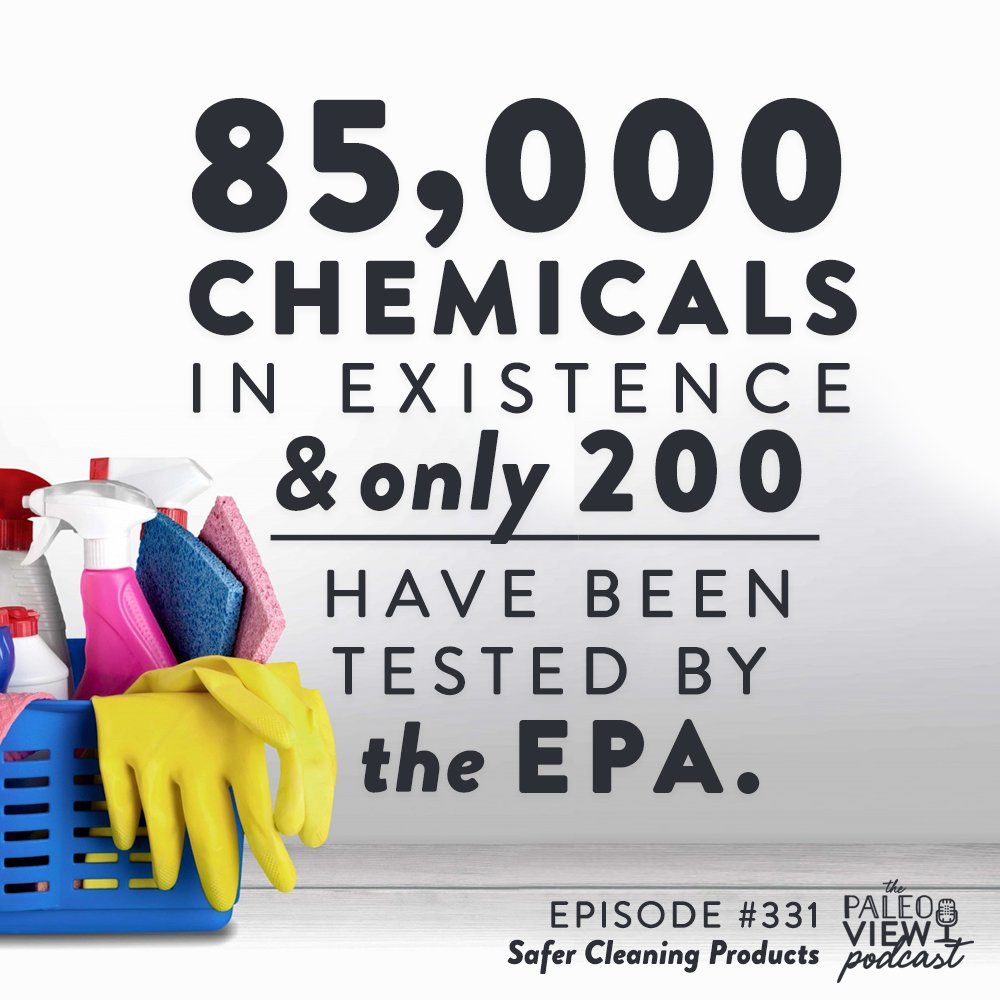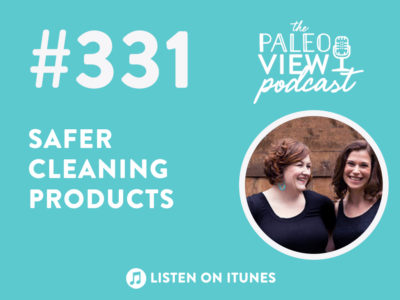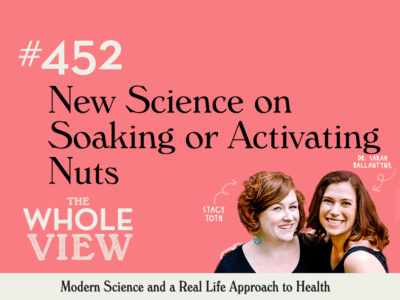In this week’s episode, Stacy takes the reigns as resident science nerd, unmasking the dark side of conventional cleaning products, the disturbing ways they impact your health, and how you can easily transition your home to use non-toxic cleaning supples.
Click here to listen in iTunes
or download and listen by clicking the PodBean Player below
![]()
If you enjoy the show, please review it in iTunes!
The Paleo View (TPV), Episode 331: Safer Cleaning Products
-
-
(0:00) Intro
-
(0:40) News and views
- Stacy is taking the reigns on today’s show! She recently researched and wrote an extensive blog post, 7 Safer Cleaning Swaps, and is going to share what she found out.
- Stacy’s husband, Matt, is a clean freak and was obsessed with Clorox Wipes until she showed him the research.
- Swapping out your cleaning products can be an overwhelming task, but Stacy and Sarah are here to help you ease into what works for you.
- A huge thanks to our show sponsor, Branch Basics. Stacy has fallen in love with their safer cleaning products!
- Their “Starter Kit + Oxygen Boost” makes it so easy to clean up your cleaning products! Once you receive the non-toxic concentrate and cleaning bottles, you simply add specific amounts of concentrate and water to each bottle to create multiple cleaning formulas!
- The Environmental Works Group recommends Branch Basics, rating their concentrate and Oxygen Boost “A” (which is the highest rating)!
- Get 15% off Branch Basics’ Starter Kit at https://branchbasics.com/partner/paleoview with code PALEOVIEW15.
-
(11:16) The Problem with Conventional Cleaning Products
- Like personal care products, cleaning products are also full of known carcinogenic and other toxic chemicals that haven’t been tested.
- 85,000 chemicals in existence and only 200 have been tested by the EPA.
- The use the EWG app to scan a product barcode and find out its safety rating.
-
-
-
- Ingredients to avoid:
- 1,4-Dioxane
- 2-Bromo-2-Nitropropane-1,3-Diol
- Alkyl Dimethyl Benzyl Ammonium Chloride
- Alkyl Dimethyl Ethylbenzyl Ammonium Chloride
- Borax and boric acid
- Didecyldimethylammonium Chloride
- Diethanolamine
- Diethylene glycol monomethyl ether (DEGME)
- Dioctyl Dimethyl Ammonium Chloride
- Distearyldimonium Chloride
- DMDM Hydantoin
- Ethanolamine
- Formaldehyde
- Fragrance**
- Glutaral
- Monoethanolamine Citrate
- Quaternary ammonium compounds, or “quats,” such as benzalkonium chloride (Quaternium-15 and Quaternium-24)
- Bleach and ammonia (sodium hypochlorite, sodium hypochlorite, and ammonium hydroxide)
- Sulfuric Acid
- Triethanolamine
- volatile organic compounds, or VOCs – include pine- and citrus-based cleaners contain a class of volatile chemicals known as terpenes which combine with ozone to form formaldehyde
- ** this is the one I so commonly see in products marked as “natural” or cleaner ingredients – it’s also where brands hide ingredients under the “fragrance loophole”
- These products emit fumes, which we then breath in and that can have a profound effect on your health.
- Avoid products that include “fragrance” in the ingredients list! This is where unregulated, health-harming chemicals can be hiding.
- We also want to be mindful of not killing our good bacteria with anti-bacterial wipes. Stacy and Matt compromised with Seventh Generation Disinfecting Wipes because they still kill flu bacteria, but via a plant-based method.
- Be weary of products scented with essential oils. Just because it’s “natural” doesn’t mean its been studied and is safe.
- Ingredients to avoid:
-
(25:02) Avoiding “Green Washing”
- Question terms like “Green,” “Natural,” and “Biodegradable.” These terms do not mean they’re non-toxic.
- One company found more than 95% of “green” consumer products violated at least one of the things Stacy discussed above. It could claim it’s “fragrance-free” but if you look closer, another name for fragrance could be hidden in the label.
- Because there’s no regulation for this!
-
(27:32) Potential Health Problems
- A lot of these health issues are triggered from respiratory issues.
- Asthma
- Skin rashes
- Chemical burns
- Poisoning
- One 2010 study showed that people who used these products while pregnant had an increased risk of birth defects.
- Even if a product is labeled “Formaldehyde-Free,” preservatives can interact with 1,4 Dioxide to create and release formaldehyde into the air.
- Another study showed the fumes of a highly scented laundry detergents or dryer sheets can vent out into the air, creating hazardous chemicals you then breathe.
- A lot of these health issues are triggered from respiratory issues.
-
(35:53) VOCs (Volatile Organic Compounds)
- These can be in a number of different products (beyond cleaning products), but in cleaning supplies, they’re known to be released from the chemicals used and contribute to chronic respiratory problems.
- The American Lung Association says cleaning supplies are affecting your lung health. They recommend avoiding:
- Aerosal spray products
- Air fresheners
- Chlorine bleach (never mix bleach with ammonia!)
- Detergent
- Dishwashing liquid
- Dry cleaning chemicals
- Rug and upholstery cleaners
- Furniture and floor polish
- Oven cleaners
- Pre-paleo Sarah used to have bad adult asthma and literally could not walk through the fragrance section of a department store. Things are much better now that she’s doing Paleo and AIP.
-
(42:02) Stacy’s Safer Cleaning Product Recommendations
- Stacy says go simple where possible!
- Keep an eye out for B Corps (like Seventh Generation). Certified B Corps not only create safer products, but give back to the environment.
- Stacy also loves Branch Basics’ Starter Kit, which comes with a concentration and an oxygen boost powder. Then it comes with instructions for how to mix the concentrate with water to create 6 different non-toxic cleaning products, including Stacy’s favorite All-Purpose cleaner!
- And Stacy can attest to the fact that Branch Basics’ products WORK. You don’t have to sacrifice.
- 7 Safer Cleaning Swaps
- Sarah notes that enzymatic cleaners are pretty cool, too. Enzymes are proteins with various activities, and cleaning-specific enzymes break apart organic material. When the enzyme eventually dries, it degrades.
- Thanks again to our episode sponsor, Branch Basics! Visit Branchbasics.com/partner/paleoview and use code PALEOVIEW15 for 15% off.
- UPDATE: Sarah has now used Branch Basics and she’s in love! She can totally back up Stacy’s love for their non-toxic cleaning products!
-
- Get your questions in! We want to hear from you! And there’s no end to questions we can answer and topics we can address!
- Engage on social media! That’s how we get feedback!
- Thank you for listening










